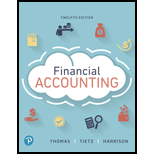
Financial Accounting (12th Edition) (What's New in Accounting)
12th Edition
ISBN: 9780134725987
Author: C. William Thomas, Wendy M. Tietz, Walter T. Harrison Jr.
Publisher: PEARSON
expand_more
expand_more
format_list_bulleted
Question
Chapter 9, Problem 9.42Q
To determine
To identify: The correct option related to current portion of long-term liabilities.
Expert Solution & Answer
Want to see the full answer?
Check out a sample textbook solution
Students have asked these similar questions
I need help solving this general accounting question with the proper methodology.
Please help me solve this general accounting problem with the correct financial process.
I need help with this general accounting problem using proper accounting guidelines.
Chapter 9 Solutions
Financial Accounting (12th Edition) (What's New in Accounting)
Ch. 9 - Brownlee Company issued 525,000, 8%, six-year...Ch. 9 - A bond with a face value of 250,000 and a quoted...Ch. 9 - Mission Furniture issued 500,000 in bonds payable...Ch. 9 - Bonds with an 8% stated interest rate were issued...Ch. 9 - Brimfest Corporation issued 2,400,000, 10-year, 6%...Ch. 9 - The Discount on Bonds Payable account a.is an...Ch. 9 - The discount on a bond payable becomes...Ch. 9 - The carrying value of Bonds Payable equals a.Bonds...Ch. 9 - Prob. 9QCCh. 9 - Prob. 10QC
Ch. 9 - Prob. 11QCCh. 9 - When a company retires bonds early, the gain or...Ch. 9 - Which type of lease will not increase a companys...Ch. 9 - Prob. 14QCCh. 9 - The debt ratio is calculated by dividing: a. total...Ch. 9 - Prob. 16QCCh. 9 - Prob. 17QCCh. 9 - Prob. 9.1ECCh. 9 - Prob. 9.1SCh. 9 - (Learning Objective 1: Determine bond prices at...Ch. 9 - (Learning Objective 1: Journalize basic bond...Ch. 9 - Prob. 9.4SCh. 9 - Prob. 9.5SCh. 9 - Prob. 9.6SCh. 9 - Prob. 9.7SCh. 9 - Prob. 9.8SCh. 9 - (Learning Objective 2: Account for bonds payable...Ch. 9 - Prob. 9.10SCh. 9 - LO 4,5 (Learning Objectives 4, 5: Deferred income...Ch. 9 - LO 5 (Learning Objective 5: Compute and evaluate...Ch. 9 - LO 5 (Learning Objective 5: Calculate the leverage...Ch. 9 - LO 6 (Learning Objective 6: Report liabilities)...Ch. 9 - (Learning Objective 1: Issue bonds payable...Ch. 9 - Prob. 9.16AECh. 9 - Prob. 9.17AECh. 9 - LO 2 (Learning Objective 2: Issue bonds payable...Ch. 9 - Prob. 9.19AECh. 9 - LO 4 (Learning Objective 4: Account for deferred...Ch. 9 - (Learning Objective 5: Evaluate debt-paying...Ch. 9 - LO 4, 5 (Learning Objectives 4, 5: Analyze current...Ch. 9 - Prob. 9.23AECh. 9 - (Learning Objective 1: Issue bonds payable...Ch. 9 - Prob. 9.25BECh. 9 - Prob. 9.26BECh. 9 - Prob. 9.27BECh. 9 - Prob. 9.28BECh. 9 - LO 4 (Learning Objective 4: Account for deferred...Ch. 9 - Prob. 9.30BECh. 9 - Prob. 9.31BECh. 9 - Prob. 9.32BECh. 9 - A bond with a face amount of 12,000 has a current...Ch. 9 - The carrying value on bonds equals Bends Payable...Ch. 9 - Prob. 9.35QCh. 9 - Prob. 9.36QCh. 9 - Prob. 9.37QCh. 9 - Prob. 9.38QCh. 9 - Prob. 9.39QCh. 9 - Prob. 9.40QCh. 9 - Prob. 9.41QCh. 9 - Prob. 9.42QCh. 9 - Prob. 9.43QCh. 9 - Prob. 9.44QCh. 9 - Prob. 9.45QCh. 9 - Prob. 9.46QCh. 9 - Prob. 9.47QCh. 9 - Prob. 9.48QCh. 9 - Prob. 9.49QCh. 9 - Prob. 9.50APCh. 9 - (Learning Objectives 1, 6: Issue bonds at a...Ch. 9 - Prob. 9.52APCh. 9 - Prob. 9.53APCh. 9 - (Learning Objectives 2, 3, 6: Issue convertible...Ch. 9 - Prob. 9.55APCh. 9 - Prob. 9.56BPCh. 9 - Prob. 9.57BPCh. 9 - Prob. 9.58BPCh. 9 - Prob. 9.59BPCh. 9 - (Learning Objectives 2, 3, 6: Issue convertible...Ch. 9 - (Learning Objectives 4, 5, 6: Report liabilities...Ch. 9 - Prob. 9.62CEPCh. 9 - Prob. 9.63CEPCh. 9 - Prob. 9.64SCCh. 9 - (Learning Objective 5: Explore an actual...Ch. 9 - Prob. 1FF
Knowledge Booster
Similar questions
- Can you explain the correct approach to solve this general accounting question?arrow_forwardWilson Manufacturing reported annual sales revenue of $4,250,000. During the year, accounts receivable decreased from a $95,000 beginning balance to a $75,000 ending balance. Accounts payable increased from a $60,000 beginning balance to a $90,000 ending balance. How much is cash received from customers for the year?arrow_forwardPlease provide the answer to this general accounting question using the right approach.arrow_forward
- Add more info and expand upon this, why, some of the things touch in the sentences the case.arrow_forwardCan you help me solve this general accounting question using the correct accounting procedures?arrow_forwardPlease help me solve this general accounting problem with the correct financial process.arrow_forward
- Subject = General Accountarrow_forwardAccounting?arrow_forwardDriftwood Furniture Company implemented a new quality control system. Product approval requires: material inspection (40% weighting), structural testing (30% weighting), and finish quality (30% weighting). If a product scored 76 on material inspection, 82 on structural testing, and 68 on finish quality, your task is to identify the weighted quality score.arrow_forward
arrow_back_ios
SEE MORE QUESTIONS
arrow_forward_ios
Recommended textbooks for you
 Cornerstones of Financial AccountingAccountingISBN:9781337690881Author:Jay Rich, Jeff JonesPublisher:Cengage Learning
Cornerstones of Financial AccountingAccountingISBN:9781337690881Author:Jay Rich, Jeff JonesPublisher:Cengage Learning

Cornerstones of Financial Accounting
Accounting
ISBN:9781337690881
Author:Jay Rich, Jeff Jones
Publisher:Cengage Learning